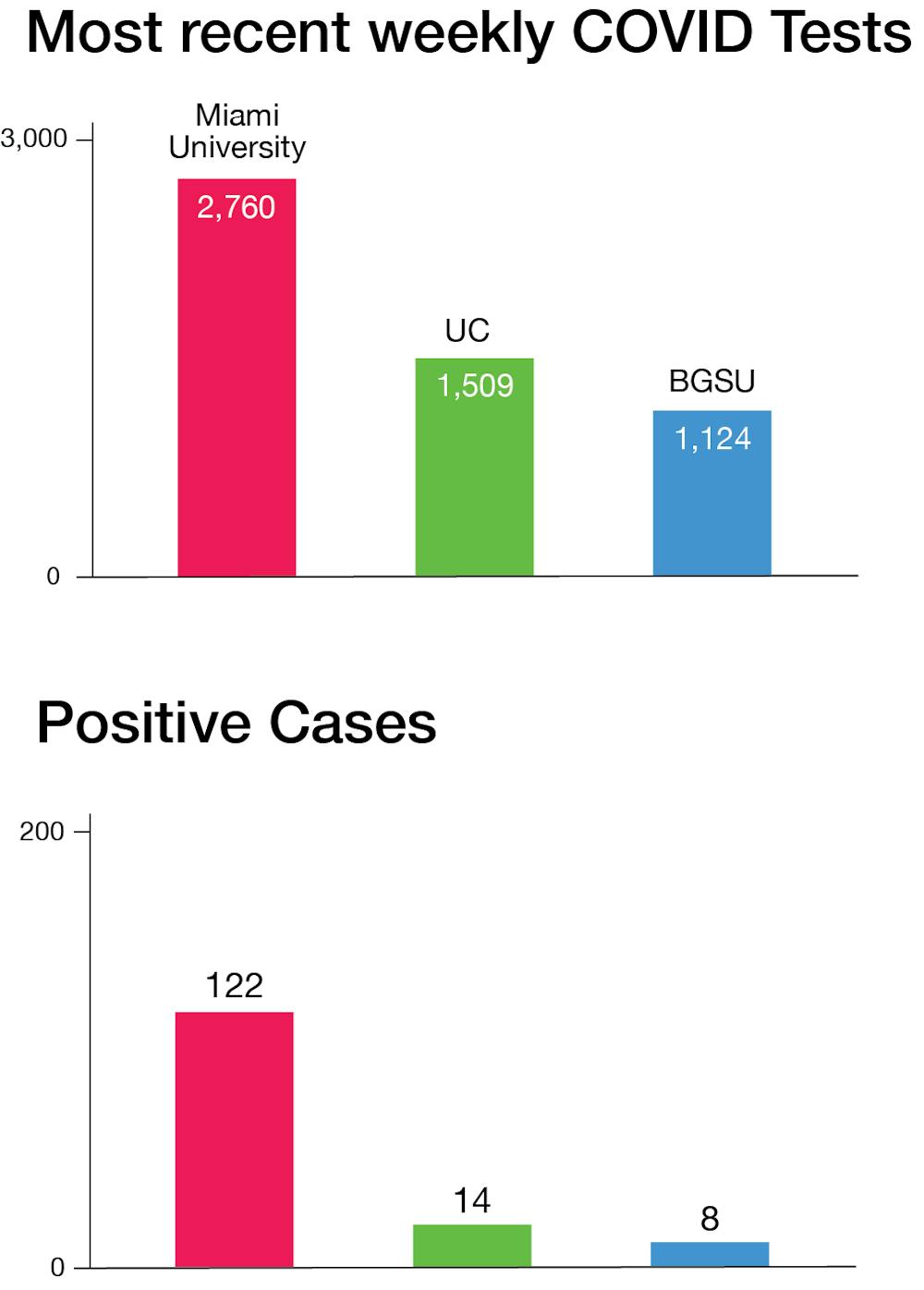While the decision to send all Ohio students home last spring was made by Gov. Mike DeWine, it was up to individual colleges on how they wanted to proceed in the 2020-2021 school year.
From replacing spring break with wellness days to altering how dining halls function, colleges across the nation have taken many precautions against COVID-19 within the past year.
How do Miami University’s COVID policies and case numbers match up against other schools in Ohio, like Bowling Green State University (BGSU) and the University of Cincinnati (UC)?
Testing Strategies
Last semester, Miami implemented random, wide-net testing for COVID-19. Students were notified at random to schedule a test, and tests were mainly nasal or throat swabs.
This semester, however, Miami changed its methods, instead focusing on surveillance testing of strategic samples. Saliva tests are taken and pooled together, and if the virus is detected in the sample, students are to return for a nasal or throat swab test. Nasal and throat swab tests are also used for symptomatic students.
Bowling Green State University (BGSU) uses randomized surveillance testing with self-administered nasal swabs. BGSU also offers free tests to all students, faculty and staff by appointment.
The University of Cincinnati (UC) opted for required and voluntary strategic mitigation testing, which its website defines as “testing that is not related to symptoms or suspected exposure,” in order to monitor trends on campus and encourage healthy habits among students. The website does not specify what type of test is used.
At UC, on-campus testing is offered only on Mondays and Tuesdays, whereas other schools offer testing every day of the week. Like BGSU, however, all testing is free. UC is also offering free “Know Before You Go” testing for students to get tested before they go home for the summer.
Campus and Academics
Miami, BGSU and UC all require face coverings and social distancing while in campus buildings. They also clean areas many times throughout the day and ask that anyone coming on campus complete a health check for any COVID symptoms.
However, there are a few differences between safety measures on each campus.
Enjoy what you're reading?
Signup for our newsletter
For example, UC requires use of the COVID Check app for conducting daily health checks. Based on a student’s answers, the app will give them a “green pass,” which allows them access to campus, a “yellow pass,” which limits access or a “red pass,” which will lead to quarantine or isolation. Students are required to show their green pass in order to access certain campus buildings.
At Miami and BGSU, daily health checks are expected. Both schools offer the Campus Clear app as a tool to conduct daily health checks, but using it is not required.
Miami and BGSU replaced spring break with five wellness days throughout the semester, and UC replaced spring break with two reading days. The spring semester lasts 16 weeks for all three schools.
All three schools currently use a combination of course delivery methods (in-person, hybrid, online synchronous and asynchronous) but differ when it comes to the fall 2021 semester.
While Miami has announced that it will return to mostly in-person classes by then, BGSU will continue mixed delivery but have more in-person options. UC also hopes to offer more in-person opportunities but doesn’t have any concrete plans yet.
Dining halls remain open at all three universities but with more options for carry-out and tables organized for social distancing. Dining hall employees also now serve students instead of students serving themselves.
Of the three schools, Miami is the only one to utilize a Remain-in-Room plan, where it assigns residence halls a level of COVID safety. If a residence hall floor reaches Level 4, that floor is quarantined.
Case Numbers
Between March 3 and March 9, Miami reported 122 new COVID cases out of 2,760 tests given.
BGSU’s COVID dashboard is updated every Tuesday. Between March 1 and March 7, it reported 1,123 tests given throughout the week and 14 positive tests.
Four of the last seven days on Miami’s dashboard reported more than 14 new cases on that day, but Miami also has a larger student population than BGSU.
UC, however, has a larger student population than Miami and reported eight positive tests out of 1,509 tests given between Feb. 27 and March 5.




